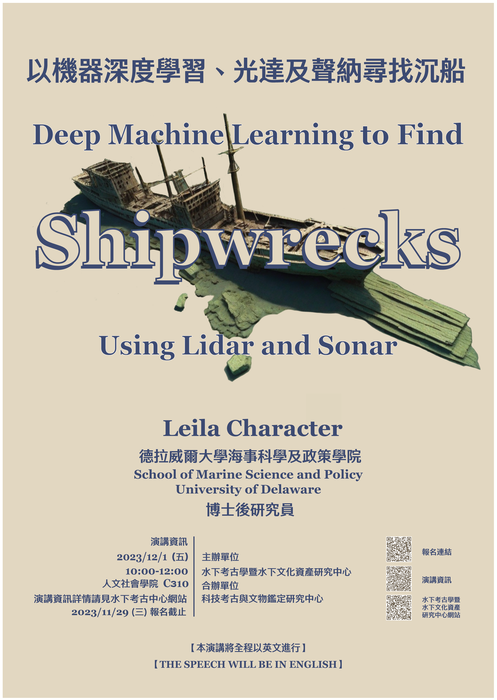【演講資訊】Deep Machine Learning to Find Shipwrecks Using Lidar and Sonar, Leila Character, 2023/12/1

演講資訊
講題|Title
Deep Machine Learning to Find Shipwrecks Using Lidar and Sonar
講者|Speaker
Dr. Leila Character
時間|Time
2023.12.1(五) 10:00-12:00
地點|Place
人文社會學院C310會議室|College of Humanities and Social Science C310
報名截止|Registration Deadline
2023/11/29(三)
報名連結|Registration link
https://forms.gle/CcpuPiLsABHVw6Rk6
主辦單位|Organizer
水下考古學暨水下文化資產研究中心|Research Center for Underwater Archaeology and Heritage
合辦單位|Co-organizer
科技考古與文物鑑定研究中心|Center for Archaeometry and Scientific Authentication
* 本次演講全程將以英文呈現
The speech will be in English.
摘要|Abstract
Machine learning changes the way that we search for shipwrecks. The integration of machine learning with remotely sensed imagery means that huge amounts of the seafloor can be searched in minutes instead of hours, or even days. Here I will discuss a methodology that uses deep machine learning, sonar, and lidar to find shipwrecks. While the use of deep learning in land-based archaeology is gaining momentum, there are very few applications in underwater archaeology. This is largely due to a lack of training data, including shipwreck locations and associated imagery. We have leveraged publicly available lidar and multibeam sonar data that cover huge amounts of bathymetry around the coast of the United States, along with a public database of GPS positions of known shipwrecks. We’ve trained a deep learning model using these data and achieved an F1 accuracy score of 92 percent. Preliminary model testing on new data show potential for detection of unknown shipwrecks and the next step is diving to ground-verify model predictions. This model can also now be used in near real-time to search for shipwrecks as remote sensing data is being collected. In addition to being able to quickly search remote sensing data, machine learning enables more targeted diving which is safer and less expensive. Time and money can instead be allocated to fieldwork and lab analyses, and thus machine learning provides the opportunity to broadly move the study of shipwrecks forward. The methodology presented here also has applications in the search for other underwater features of archaeological interest, as well as land-based features. This work more broadly seeks to develop methodologies that can be applied across a spectrum of projects, including those that are under water as well as on land.
講者簡介|Speaker introduction
Dr. Leila Character
Postdoctoral Researcher
School of Marine Science and Policy
University of Delaware
講題|Title
Deep Machine Learning to Find Shipwrecks Using Lidar and Sonar
講者|Speaker
Dr. Leila Character
時間|Time
2023.12.1(五) 10:00-12:00
地點|Place
人文社會學院C310會議室|College of Humanities and Social Science C310
報名截止|Registration Deadline
2023/11/29(三)
報名連結|Registration link
https://forms.gle/CcpuPiLsABHVw6Rk6
主辦單位|Organizer
水下考古學暨水下文化資產研究中心|Research Center for Underwater Archaeology and Heritage
合辦單位|Co-organizer
科技考古與文物鑑定研究中心|Center for Archaeometry and Scientific Authentication
* 本次演講全程將以英文呈現
The speech will be in English.
摘要|Abstract
Machine learning changes the way that we search for shipwrecks. The integration of machine learning with remotely sensed imagery means that huge amounts of the seafloor can be searched in minutes instead of hours, or even days. Here I will discuss a methodology that uses deep machine learning, sonar, and lidar to find shipwrecks. While the use of deep learning in land-based archaeology is gaining momentum, there are very few applications in underwater archaeology. This is largely due to a lack of training data, including shipwreck locations and associated imagery. We have leveraged publicly available lidar and multibeam sonar data that cover huge amounts of bathymetry around the coast of the United States, along with a public database of GPS positions of known shipwrecks. We’ve trained a deep learning model using these data and achieved an F1 accuracy score of 92 percent. Preliminary model testing on new data show potential for detection of unknown shipwrecks and the next step is diving to ground-verify model predictions. This model can also now be used in near real-time to search for shipwrecks as remote sensing data is being collected. In addition to being able to quickly search remote sensing data, machine learning enables more targeted diving which is safer and less expensive. Time and money can instead be allocated to fieldwork and lab analyses, and thus machine learning provides the opportunity to broadly move the study of shipwrecks forward. The methodology presented here also has applications in the search for other underwater features of archaeological interest, as well as land-based features. This work more broadly seeks to develop methodologies that can be applied across a spectrum of projects, including those that are under water as well as on land.
講者簡介|Speaker introduction
Dr. Leila Character
Postdoctoral Researcher
School of Marine Science and Policy
University of Delaware
